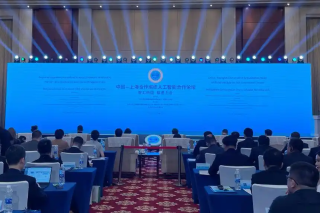Tianjin and the Haihe - its ‘Mother River’
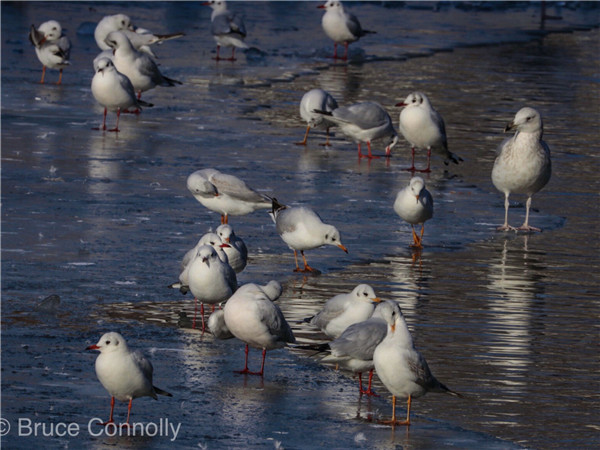
Migratory Black-headed Gulls on Hate River near the Grand Canal 2020
Tianjin’s commercial position and its connectivity between Beijing, the Grand Canal and the Bohai Gulf was noticed by Western nations wanting a foothold in China during the mid-19th century. European countries, in particular, were pressing for greater commercial and diplomatic privileges. Treaties extracted by Britain and France during the Second Opium War (1856-60), signed in 1858, allowed those countries to start setting up concession areas within Tianjin. Other countries would follow over coming years.
Several large western companies established grand, classical-style offices, particularly along Jiefang Beijie. The street for a while known as Asia’s first Wall Street. This led also to greatly increased interantional ship movements into and out of the Haihe, along with considerable growth of the city. Extensive areas resembled more European cities than the older, early Tianjin. The city walls were destroyed by western troops in1900.
Ironically, even as traffic on the Haihe was increasing, the Grand Canal was steadily silting up. It was a time of increasingly weak governance in China as the Qing era was crumbling and little thought was given to maintaining of vital infrastructure.
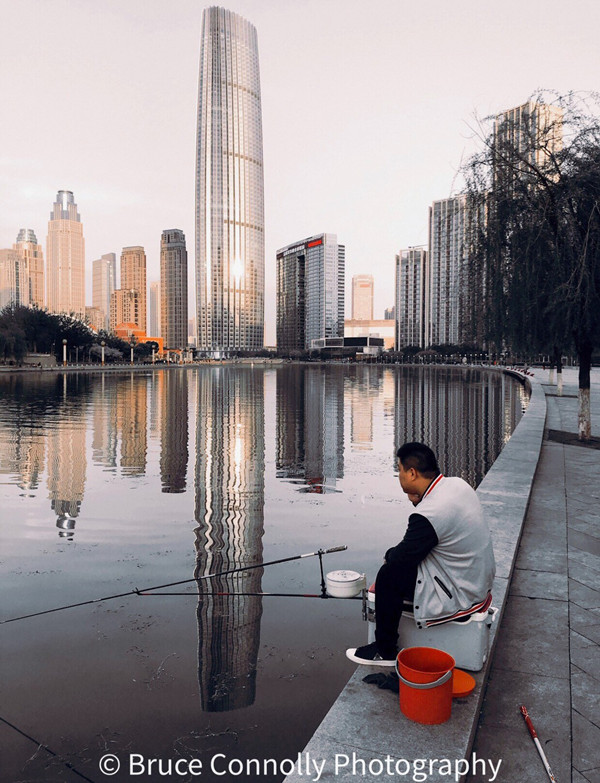
Looking towards Tianjin International Finance Centre 2019
Tianjin’s Haihe took on a different semblance than Shanghai’s Huangpu. There the city had its main commercial buildings spread along the Bund, the waterfront of the city. With Tianjin, the riverbanks were mostly given over to berthing for boats, storage warehouses, trading points. It was also quite a marshy, seemingly rundown area which became increasingly neglected. Commercial traffic on the river declined during the early and into mid-20th century. Also, just like my home city, Glasgow, large scale commercial shipping moved downriver. For Tianjin this was to the vast deepwater container port on the edge of the Bohai Gulf.
Over the last ten years in particular, returning regularly to Tianjin I noticed changes gradually happening along the Haihe. However, it was February 2017, emerging from the Railway Station I could see massive work had gone on in transforming the river into a pleasant park and environmental corridor. Initially passing through the central areas but increasingly farther along the banks from where heavy industry has steadily been disappearing.
Today people have a traffic-free area, with trees, flower beds and areas for safe walking. New buildings have also stimulated a positive feel for the downtown area. Indeed, illuminated at night, Tianjin has become known as a ‘City of Bridges. A City of lights.’
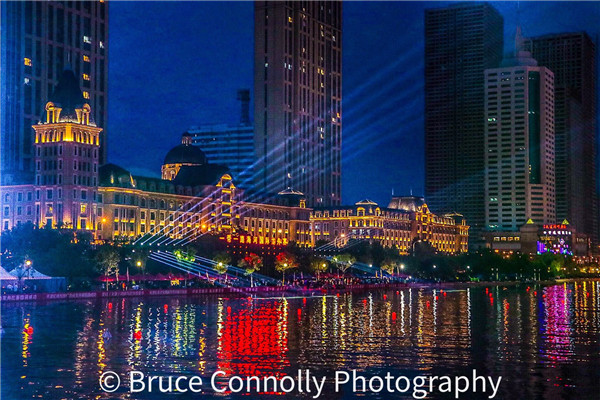
Tianjin -a City of Lights 2019
A focal point within the riverside renovations is historic Jiefang Bridge, a steel girder cantilever opening bridge dating from 1927. It still operates, being centerpiece for example on 1October last year, China’s 70th National Day. Cruise boats pass along day and night between piers near the Railway Station up to the Tianjin Eye. Evening sails are particularly popular with an often dazzling display of lights on most riverside buildings and all the bridges.
Apart from such displays and cruises, simply walking along the banks is an excellent way to appreciate the everyday lives of local people. Many sit fishing, some swim, others exercise, play musical instruments or even sing. In the evening, women, in particular, gather for formation, line dancing.
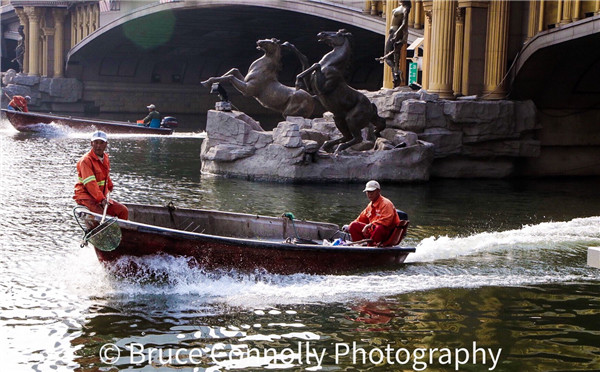
Environmental workers on Haihe River 2018
There are also small boats operating daily, environmental vessels keeping the waters clean. An occasional fishing boat will come upriver while sometimes people on jet skis race along its course.
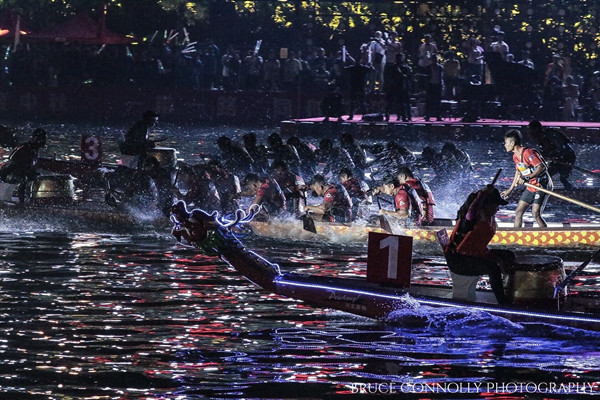
Dragon Boat racing on the Haihe River 2019
Viewing the central areas of the river and indeed the CBD of Tianjin from above is quite spectacular, particularly when viewed from Tianjin International Finance Centre.
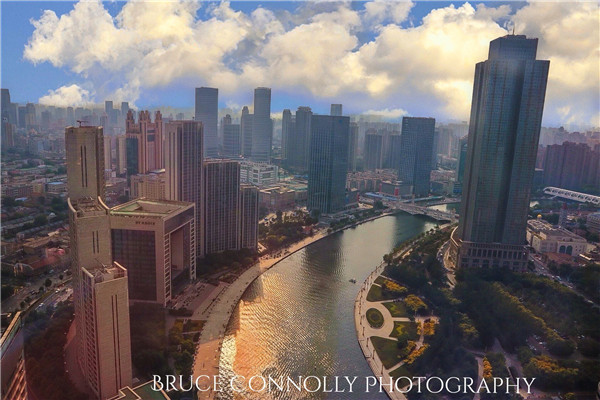
Haihe bend at CBD viewed from Tianjin Interantional Centre 2019
In the evenings, from the Shangri-La Hotel’s 33rd floor Horizon Lounge, having a cold drink while looking over the river lit up in an often multi-coloured display, can be breathtaking.
However, look the other direction from the hotel, downriver past older industrial areas towards the sea mouth. A very different area that can be traversed along Metro Line 9 down to Tanggu, the early seaport for Tianjin. Tanggu’s Hebin Park, another environmental area replacing docklands and commercial activities, has a viewing platform giving spacious views across the now much wider river. Beyond, the contemporary high-rise skyline of Yujiapu forms a quite striking landscape in contrast to many previous port-related facilities once found there.
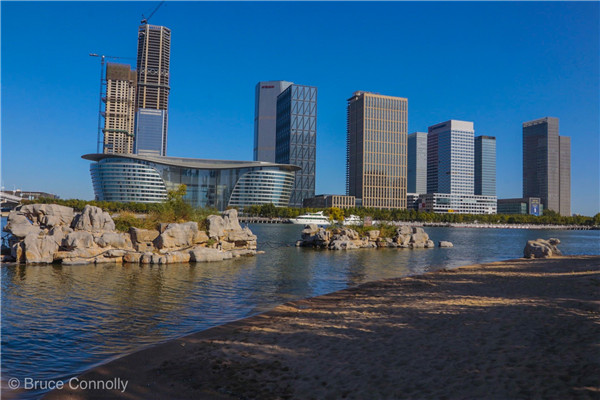
Yujiapu and the Haihe River 2019
Finally, the sea mouth, the estuary, dominated by one of the world’s largest ports. It maintain’s one of Tianjin’s roles as an interchange between land and sea for Beijing and much of northeastern China.
In the high-up lounge of the Shangri-La, there is a library of books on historic and modern Tianjin. I never tire of reading while also looking out on the city, the ‘Heavenly Ford and its river, the Haihe. The city and the river are intertwined. While the Haihe helped make Tianjin it was the people of the city who helped create its vital, ‘Sea River’, its ‘Mother River.’

Copyright ©
Tianjin Municipal Government. All rights reserved. Presented by China Daily.
京ICP备13028878号-35


